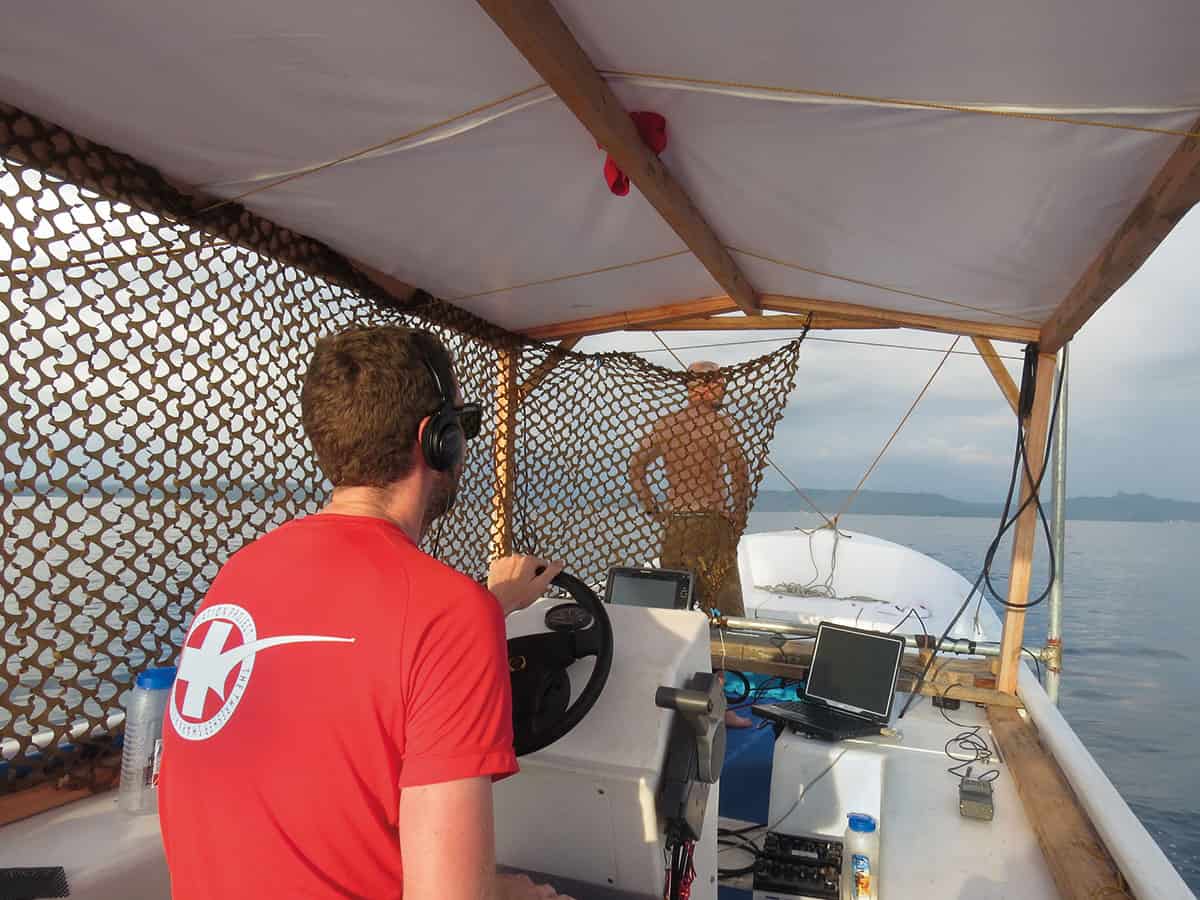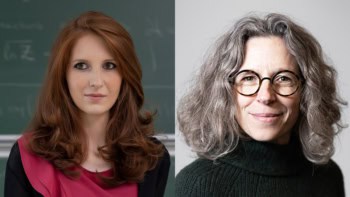Pelagic thresher sharks are a sight to behold, but their numbers are dwindling as a result of illegal hunting and fishing. Now, however, scientists are using acoustics to learn more about these animals’ behaviour and how they can be better protected. Louise Murray looks under the surface

The shimmering turquoise seas that surround the 7641 islands of the Philippines host a colourful array of wildlife. But there’s one spot, the Monad Shoal, that has a special claim – it’s the only place in the world where you can reliably see the pelagic thresher shark. These ocean-roaming animals – also known by their biological name Alopias pelagicus – are the smallest of the three types of thresher sharks. Typically reaching about 3 m in size, around half that length comes from their extremely long tail fins, which they use to whip and stun prey.
Lying in the Visayan Sea about 8 km from Malupascua Island, the Monad Shoal is a 1.5 km-long underwater rise, or “seamount”. In places, it comes to within 20 m of the water’s surface but drops to depths of 250 m at the edges. The pelagic thresher sharks visit this flat-topped structure to be cleaned at discrete “stations” by specialized fish that snack on the parasites infesting the sharks’ skin, gills and cloacal region (the area from which the animal excretes both urine and faeces).
The rare sharks draw tourists to the seamount from far and wide. The economic benefit of dive tourism has encouraged the local community to fund an organization called Bantay Dagat – or the “Guardians of the Sea” – to protect the sharks from being illegally fished. But the pelagic thresher sharks are highly migratory and, when they venture further afield, they find themselves being targeted for their meat, fins, skin and liver oil. Fishing lines set for smaller fish threaten them too.
Combined with the animals’ low rate of reproduction due to small litters (maximum two pups) and long gestation periods, these pressures mean that the numbers of pelagic thresher sharks are declining. Indeed, the species is listed as vulnerable by the International Union for the Conservation of Nature, which is made up of some 1400 governmental and non-governmental agencies around the world.
Roaming to the unknown
Until recently, scientists had little idea how far individual sharks that visit the seamount roam. With that in mind, Simon Oliver, a marine ecologist from the University of Chester in the UK, and his colleagues set out in 2014 to track the sharks using acoustic tagging (Biological Conservation 230 58). “We decided that we needed to understand how these animals use this part of the Indo-Pacific Ocean in order to better protect them,” says Oliver, who has studied threshers for 15 years and was the first to explain why these sharks frequent the seamount.

As the sharks are sometimes skittish, the researchers couldn’t attach the tags by sending down scuba divers, whose noisy bubbles would scare the animals and prevent them from approaching the sharks closely. Instead, they used free divers (who can hold their breath for long periods) and divers on rebreathers (closed life-support systems that don’t emit bubbles). “It’s not easy,” admits Oliver when talking about attaching the tags. “We have to be within a metre of the animal and aim in to a precise muscle group behind the dorsal fin.” Indeed, it took the team three weeks to attach 14 tags.
Each tag transmitted pulses of sound – or “pings” – at a unique transmission frequency, enabling the researchers to identify individual animals. To passively track the sharks, the team used four moored submersible data loggers, each around half a metre high, placed around Monad Shoal at known cleaning stations. These instruments recorded data for 66 days, and the researchers found that each shark had favoured cleaning stations, which it would mostly visit in the early morning before moving away from the seamount.
Once a tagged shark was on the move, the team could continue to track it using acoustic telemetry. The sound emitted by the tags was picked up by a hydrophone – or underwater microphone – installed on a boat, allowing the researchers to listen in on headphones and follow the pinging sharks from above. This active tracking revealed that most sharks swim along a specific corridor that the researchers dubbed the “shark highway” on their way to forage for food – a supposition supported by depth and pressure changes recorded by the tags.
Acoustic toolbox

In water, sound can travel a long way, with the precise distance depending on the frequency. Indeed, low-frequency sound from baleen whale calls can travel up to 3000 km. Some animals, such as dolphins, also use sound to communicate with each other underwater, whether within their family groups or across distances to others nearby. They also use echolocation to find prey at distances of over 100 m by detecting the bounce back of the sounds that they generate.
As well as detecting the sounds animals themselves make, scientists exploit acoustic tagging, which has become a standard tool in the marine biologist’s arsenal. Indeed, researchers have been using high-frequency sound between 60 and 180 kHz to track animals underwater for more than 50 years. The smallest tags are now only 5 mm long, allowing scientists to even track juvenile fish.
Hunted hunters
The tracking also revealed that the pelagic threshers move at an average speed of nearly 4 km/h. Travelling at this rate means the sharks can in principle swim through five jurisdictions on any given day (although the tracking research did not verify this as it was too localized). Unfortunately for the animals, their degree of protection varies as they travel. In the Leyte jurisdiction, the sharks are at risk of becoming bycatch in Indian sardine fisheries or of being targeted because they foul fishing gear. In Cebu they are protected because they generate tourist revenue but may be at risk from fisheries in areas with fewer tourists. In other jurisdictions, the animals are targeted for their meat and fins. At least five territorial governments in the Philippines would have to co-ordinate their efforts if the sharks are to be effectively protected.
Oliver hopes to improve conservation measures throughout the archipelago with his Thresher Shark Research and Conservation Project. He also aims to continue investigating the thresher’s movements by using satellite tagging. The problem with acoustic monitoring is that it is only local and you need to be in a certain range to pick up the “pings”. Satellite tracking, in contrast, would allow the team to monitor the animals’ movements on a much larger scale. After attaching the satellite tags to the sharks, the scientists would have to wait patiently until the tags detach after a pre-programmed time interval of some months, then float to the surface and transmit data to a receiving satellite.

Tracking pelagic thresher sharks
Oliver also plans to study the genetics of the local population to determine whether there is risk of inbreeding or a healthy exchange of different animals visiting the site. Thankfully, his research is supported by members of the local community, who are well aware of the importance of dive visitors who come to see the rare sharks, and make a significant contribution to the local economy.



